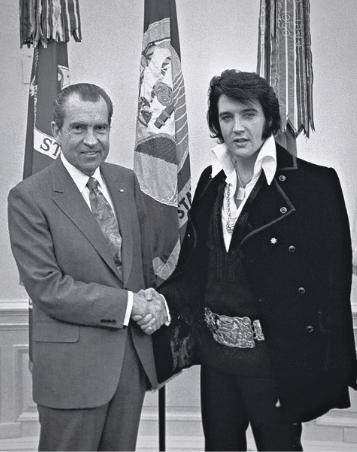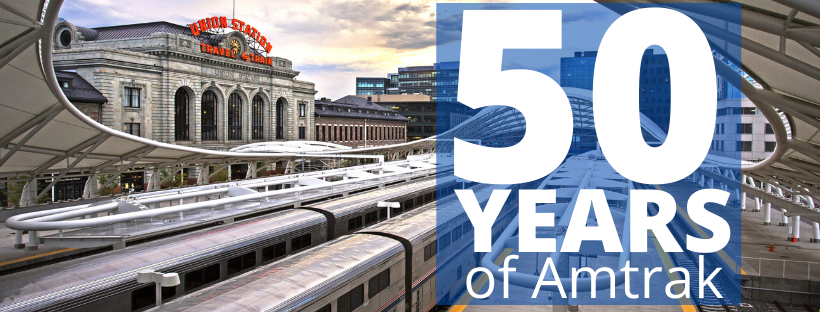Fifty years of Amtrak
This year sees the 50th anniversary of the United States National Railroad Passenger Corporation, better known to the wider travelling public as Amtrak.
In 1971, the company was founded as a for-profit company, wholly-owned by the federal government, but run with funding from from federal and State subsidies. Amtrak routes now cover 46 states and three Canadian provinces, serve more than 500 destinations and the company’s 300 daily trains run on more than 21,400 miles of track.

In October 1970 President Richard Nixon signed into law, the Rail Passenger Service Act. The original working brand name for NRPC was Railpax, but less than two weeks before operations began, the official marketing name was changed to Amtrak. There key provisions of the Rail Passenger Service Act were
- Any railroad operating intercity passenger service could contract with the NRPC, thereby joining the national system.
- Participating railroads bought into the NRPC using a formula based on their recent intercity passenger losses. The purchase price could be satisfied either by cash or rolling stock; in exchange, the railroads received NRPC common stock.
- Any participating railroad was freed of the obligation to operate intercity passenger service after May 1, 1971, except for those services chosen by the Department of Transportation (DOT) as part of a “basic system” of service and paid for by NRPC using its federal funds.
- Railroads that chose not to join the NRPC system were required to continue operating their existing passenger service until 1975 and thenceforth had to pursue the customary ICC approval process for any discontinuance or alteration to the service.
Through this Act, the US Federal Government effectively mandated the provision of intercity rail services, ensured competition on the routes was controlled and set the rail companies outside the sole obligation of satisfying shareholder returns.

Launched in the 1970s following many years of falling railroad passenger numbers, Amtrak’s future seemed secure when the Rail PAssenger Services Act was passed.
Within a year, it had opened its first, new station – River Road in Cincinnati and had introduced international services to Vancouver and Montreal in Canada and, a year later, a service to Laredo, where passengers could cross the border and hop on to Mexican rail services.
In 1977 Amtrak and the federal government kicked off a $1.75bn Northeast Corridor Improvement Program to improve rail infrastructure and, crucially, to cut journey times between Washington, New York and Boston.

The 1980s saw Amtrak make signifcant investments in its fleet and open new routes.
For the first time, Amtrak was able to sell its services through travel agencies, enabling it to offer services in conjunction with – and in competition with – airlines.
By the end of the decade, Amtrak passenger numbers between Washington DC and New York exceeded the numbers of passengers on all airlines, combined.

In the 1990s, Amtrak continued to invest in its fleet and infrastructure and, with local governmnet funding, to open new routes.
But it remained determined to preserve the heritage of the real estate portfolio, spending $30m renovating Philadelphia’s Art Deco 30th Street Station and $32m on Chicago’s Union Station.
As well as aesthetics, Amtrak remained focused on efficiency and safety, with the modernisation of New York’s Penn Station Control Center and the deployment of 111 new diesel locomotives with greatly enhanced fuel efficiency.
And, in the middle of the decade, amtrak.com was launched, later to be enhanced with booking capabilities.

The 2000s saw Amtrak develop its offering by adding more multi-modal opportunities, better rewards for frequent passengers and a faster service.
The first Acela Express, ‘high-speed rail’ service was introduced, reducing journey times – later enhanced with at-seat food and drink service. Milwaukee General Mitchell Airport Station was opened, paving the way for more and better air-and-rail services. And the introduction of the Amtrak Guest Reward programme enabled passengers to earn points that can be redeemed for hotels and car hire.
Reflecting the continued passenger-focus, Amtrak saw more than 24 million passengers per year for the first time.

The second decade of the century saw Amtrak enhance its passenger experience, while continuing investment on infrastructure and real estate.
To satisfy the needs of an increasingly business travel oriented service, Amtrak installed free Wi-Fi at New York Penn Station, Washington Union Station, Boston South Station, Philadelphia 30th Street Station, Baltimore Penn and Wilmington, Delaware.
And ‘Amtrak Connect’ rolled out to 450 Amfleet cars, providing nearly 75% of all Amtrak passengers with free Wi-FI.
Meanwhile, almost all Amtrak-owned track was upgraded with Positive Train Control – an automated safety system which matches train speeds to autonomously detected track conditions.

Despite the unprecedented challenge of the Covid-19 pandemic, Amtrak has continued to upgrade its services.
Digital platforms have been enhanced so that customers can access reservations and booking systems from computers, tablets and phones.
And customers to see online how full their train is at time of booking.
And Amtrak continues to test the new Acela trainsets at the Transportation Technology Center near Pueblo, Colorado and along the Northeast Corridor.
In its fifty-year history, Amtrak has had six different liveries.









